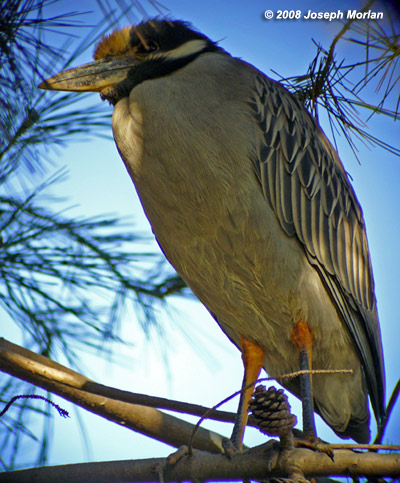Fourth Street & Caspian Way, Imperial Beach, San Diego County, California
31 January 2008
Joseph Morlan
Photo
 s © 29 January
2008 by Joseph Morlan. All rights reserved. Larger image here.
s © 29 January
2008 by Joseph Morlan. All rights reserved. Larger image here. Yellow-crowned Night-Heron (Nyctanassa violacea)
Fourth Street & Caspian Way, Imperial Beach, San Diego County, California
31 January 2008
Joseph Morlan
Photo s © 29 January
2008 by Joseph Morlan. All rights reserved. Larger image here.
s © 29 January
2008 by Joseph Morlan. All rights reserved. Larger image here.
Guy McCaskie kindly agreed to show Robbie Fischer and me, the pair of Yellow-crowned Night-Herons which has been present continuously since 27 June 2005. We easily saw the two adults and one juvenile roosting in a conifer. The juvenile fledged from a nearby nest last summer. I was able to digiscope one of the adults and the juvenile, but they were largely hidden in a dense conifer, making photography difficult. One adult bird is below right and the juvenile is to the upper left.
I did not take notes at the time, but concentrated instead on photography. I was particularly interested in
the juvenile which still showed some pale at the base of the mandible. This pale coloration was more evident on
the right side of the bill than on the left. 
One difference between juveniles of the Yellow-crowned Night-Heron and the similar Black-crowned Night-Heron (Nycticorax nycticorax) is that the Yellow-crowned supposedly has an all black bill, while Black-crowned has a largely yellow or greenish mandible.
This individual makes clear that this supposed difference is unreliable. Even the adult bird on the right has considerable yellow on its bill, possibly from an environmental source. A more reliable difference is the bill shape. In Yellow-crowned, the mandible is thick and upturned, meeting the maxilla evenly, producing a stout overall bill shape. In Black-crowned the lower mandible is thinner and straight or slightly downcurved, producing an overall thinner more downturned looking bill.
Discussion
Including this pair, California has at least 26 accepted records of Yellow-crowned Night-Heron, mostly from Southern California where the species has hybridized occasionally with the Black-crowned Night-Heron and at least once produced hybrid offspring.
This pair also nested successfully in 2006 when they produced three young. The record has been accepted by the California Bird Records Committee (record #2005-079) and a photo of one of the adults appears on page H-15 of the recently published "Rare Birds of California."